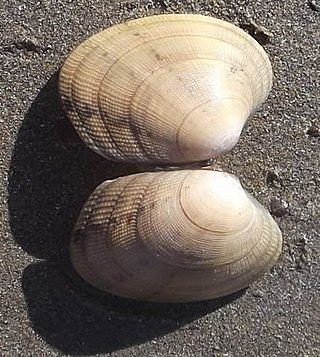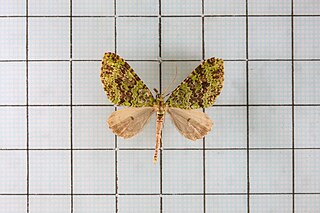
Microbiota is a monotypic genus of evergreen coniferous shrubs in the cypress family Cupressaceae, containing only one species, Microbiota decussata. The plant is native and endemic to a limited area of the Sikhote-Alin mountains in Primorskiy Krai in the Russian Far East. Microbiota is not to be confused with the range of microorganisms of the same name. The genus name was derived from micro-, meaning "small", + Biota, the genus name for a closely related conifer, a species formerly called Biota orientalis, now renamed Platycladus orientalis.

Pedicularia is a genus of small predatory or ectoparasitic sea snails, cowry-like marine gastropod molluscs in the family Ovulidae, the cowry allies.
Pouteria decussata is a species of plant in the family Sapotaceae. It is endemic to Brazil.

Verticordia decussata is a flowering plant in the myrtle family, Myrtaceae and is endemic to an area in the north of the Northern Territory. It is an open shrub with distinctive leaves and leaf arrangement and small spikes of cream to white flowers on the ends of the branches.

The Cuban slider is a species of turtle native to Cuba, but has also been introduced to Grand Cayman and Cayman Brac in the Cayman Islands, and Marie Galante in Guadeloupe.

Bela decussata is a species of sea snail, a marine gastropod mollusk in the family Mangeliidae.

Distorsio decussata, common name the decussate distorsio, is a species of medium-sized sea snail, a marine gastropod mollusk in the family Personidae, the Distortio snails.

Geyeria decussata is a moth in the Castniidae family.

Venerupis decussata is a marine bivalve mollusc in the family Veneridae, commonly known as the cross-cut carpet shell.

Melaleuca decussata, commonly known as cross-leaf honey-myrtle or totem poles, is a plant in the myrtle family, Myrtaceae native to South Australia and both native and naturalised in Victoria. It is an adaptable shrub, grown in many parts of Australia for its attractive foliage but is regarded as an environmental weed in parts of Victoria.

Schistostege decussata is a moth of the family Geometridae. It is found in south-eastern and eastern Europe up to Ukraine. In Hungary and Lower Austria, the yellow-brown form is found.

Tristeirometa decussata is a moth of the family Geometridae first described by Frederic Moore in 1868. It is found in north-eastern India and Taiwan.
Cyclophora decussata is a moth in the family Geometridae. It is found in Suriname, French Guiana and Brazil.

Homelix is a genus of longhorn beetles of the subfamily Lamiinae, containing the following species:

Allocasuarina decussata, commonly known as karri oak or karri she-oak, is a species of flowering plant in the family Casuarinaceae and is endemic to the southwest of Western Australia. It is an understory tree in karri forest but also occurs as a stunted shrub in places like Bluff Knoll in the Stirling Range.

Pavona decussata, sometimes known as leaf coral, is a species of colonial stony coral in the family Agariciidae. It is found in shallow water in various reef habitats, particularly on gently sloping surfaces, in tropical parts of the western and central Indo-Pacific region.

Homelix arcuata is a species of beetle in the family Cerambycidae. It was described by Louis Alexandre Auguste Chevrolat in 1855, originally under the genus Pachystola. It is known from Gabon, Cameroon, and Nigeria.
Homelix morini is a species of beetle in the family Cerambycidae. It was described by Pierre Téocchi in 1999. It is known from Cameroon, the Democratic Republic of the Congo, and the Central African Republic.
Homelix variegata is a species of beetle in the family Cerambycidae. It was described by Karl Jordan in 1894. It is known from the Republic of the Congo, the Democratic Republic of the Congo, and Gabon. It feeds on Coffea canephora.
Homelix klingi is a species of beetle in the family Cerambycidae. It was described by Kolbe in 1893. It is known from the Central African Republic, Sierra Leone, the Ivory Coast, Kenya, the Democratic Republic of the Congo, Mali, Tanzania, Cameroon, Togo, and Zambia.














